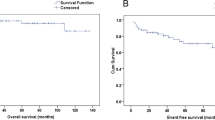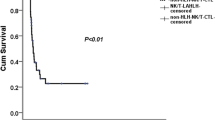Abstract
Lymphoplasmacytic lymphoma (LPL) constitutes less than 5% of all non-Hodgkin lymphomas, and little is known about clinical features and treatment outcomes for patients with LPL in East Asia. In this study, we summarize our experiences managing patients diagnosed with LPL in Korea. A retrospective analysis was performed using data for 22 patients with LPL diagnosed at Samsung Medical Center. LPL was more common among males (77.3%), with a median age of diagnosis of 63 years (range 26-86). The most common presenting symptom was fatigue related to anemia (59.1%), and the bone marrow was commonly involved at diagnosis (90.9%). IgM paraproteinemia was found in 15 patients, and only one patient had anti-hepatitis C virus. Although some patients could be observed without treatment, the majority of patients required systemic treatment. Chlorambucil alone and cyclophosphamide, doxorubicin, vincristine, and prednisolone (CHOP) or CHOP-like combination chemotherapy was frequently used as a first-line treatment, and a fludarabine-based regimen was commonly used as salvage therapy. However, responses to those treatments were not satisfactory. Even patients who could be monitored without therapy became refractory to salvage therapies once their disease progressed. Eight patients died due to disease progression, and the median overall survival was 70.8 months (95% CI: 31.4-109.2 months). This study describes the clinical features and treatment outcome of LPL in Korea. The treatment approach was too heterogeneous to draw firm conclusions, however, and treatment recommendations in the future should utilize a uniform treatment strategy.

Similar content being viewed by others
References
Swerdlow SH, Campo E, Harris NL et al (2008) WHO classification of tumors of hematopoietic and lymphoid tissues. IARC press, Lyon, pp 194–195
Treon SP, Dimopoulos MKyle RA (2003) Defining Waldenstrom's macroglobulinemia. Semin Oncol 30:107–9
Dimopoulos MA, Kyle RA, Anagnostopoulos A et al (2005) Diagnosis and management of Waldenstrom's macroglobulinemia. J Clin Oncol 23:1564–77
Papamichael D, Norton AJ, Foran JM et al (1999) Immunocytoma: a retrospective analysis from St Bartholomew's Hospital-1972 to 1996. J Clin Oncol 17:2847–53
Herrinton LJWeiss NS (1993) Incidence of Waldenstrom's macroglobulinemia. Blood 82:3148–50
Groves FD, Travis LB, Devesa SS et al (1998) Waldenstrom's macroglobulinemia: incidence patterns in the United States, 1988-1994. Cancer 82:1078–81
Ohshima K, Suzumiya J, Sato K et al (1999) B-cell lymphoma of 708 cases in Japan: incidence rates and clinical prognosis according to the REAL classification. Cancer Lett 135:73–81
Haddadin WJ (2005) Malignant lymphoma in Jordan: a retrospective analysis of 347 cases according to the World Health Organization classification. Ann Saudi Med 25:398–403
Treon SP, Gertz MA, Dimopoulos M et al (2006) Update on treatment recommendations from the Third International Workshop on Waldenstrom's macroglobulinemia. Blood 107:3442–6
Ko YH, Kim CW, Park CS et al (1998) REAL classification of malignant lymphomas in the Republic of Korea: incidence of recently recognized entities and changes in clinicopathologic features. Hematolymphoreticular Study Group of the Korean Society of Pathologists. Revised European-American lymphoma. Cancer 83:806–12
Vitolo U, Ferreri AJMontoto S (2008) Lymphoplasmacytic lymphoma-Waldenstrom's macroglobulinemia. Crit Rev Oncol Hematol 67:172–85
Mele A, Pulsoni A, Bianco E et al (2003) Hepatitis C virus and B-cell non-Hodgkin lymphomas: an Italian multicenter case-control study. Blood 102:996–9
Takeshita M, Sakai H, Okamura S et al (2006) Prevalence of hepatitis C virus infection in cases of B-cell lymphoma in Japan. Histopathology 48:189–98
Singh A, Eckardt KU, Zimmermann A et al (1993) Increased plasma viscosity as a reason for inappropriate erythropoietin formation. J Clin Invest 91:251–6
Garcia-Sanz R, Montoto S, Torrequebrada A et al (2001) Waldenstrom macroglobulinaemia: presenting features and outcome in a series with 217 cases. Br J Haematol 115:575–82
Dimopoulos MA, Kastritis E, Delimpassi S et al (2008) The international prognostic scoring system for Waldenstrom's macroglobulinemia is applicable in patients treated with rituximab-based regimens. Haematologica 93:1420–2
O'Brien ME, Easterbrook P, Powell J et al (1991) The natural history of low grade non-Hodgkin's lymphoma and the impact of a no initial treatment policy on survival. Q J Med 80:651–60
Kyle RA, Treon SP, Alexanian R et al (2003) Prognostic markers and criteria to initiate therapy in Waldenstrom's macroglobulinemia: consensus panel recommendations from the Second International Workshop on Waldenstrom's Macroglobulinemia. Semin Oncol 30:116–20
Dhodapkar MV, Jacobson JL, Gertz MA et al (2001) Prognostic factors and response to fludarabine therapy in patients with Waldenstrom macroglobulinemia: results of United States intergroup trial (Southwest Oncology Group S9003). Blood 98:41–8
Buske C, Hoster E, Dreyling M et al (2009) The addition of rituximab to front-line therapy with CHOP (R-CHOP) results in a higher response rate and longer time to treatment failure in patients with lymphoplasmacytic lymphoma: results of a randomized trial of the German Low-Grade Lymphoma Study Group (GLSG). Leukemia 23:153–61
Dimopoulos MA, Gertz MA, Kastritis E et al (2009) Update on treatment recommendations from the Fourth International Workshop on Waldenstrom's Macroglobulinemia. J Clin Oncol 27:120–6
Coleman M, Leonard J, Lyons L et al (2003) Treatment of Waldenstrom's macroglobulinemia with clarithromycin, low-dose thalidomide, and dexamethasone. Semin Oncol 30:270–4
Treon SP, Hunter ZR, Matous J et al (2007) Multicenter clinical trial of bortezomib in relapsed/refractory Waldenstrom's macroglobulinemia: results of WMCTG Trial 03-248. Clin Cancer Res 13:3320–5
Gilleece MH, Pearce R, Linch DC et al (2008) The outcome of haemopoietic stem cell transplantation in the treatment of lymphoplasmacytic lymphoma in the UK: a British Society Bone Marrow Transplantation study. Hematology 13:119–27
Acknowledgments
This study was supported by the Samsung Medical Center Clinical Research Development Program grant, #CRS-109-03-1.
Author information
Authors and Affiliations
Corresponding author
Rights and permissions
About this article
Cite this article
Won, YW., Kim, S.J., Kim, K. et al. Clinical features and treatment outcomes of lymphoplasmacytic lymphoma: a single center experience in Korea. Ann Hematol 89, 1011–1018 (2010). https://doi.org/10.1007/s00277-010-0978-1
Received:
Accepted:
Published:
Issue Date:
DOI: https://doi.org/10.1007/s00277-010-0978-1




